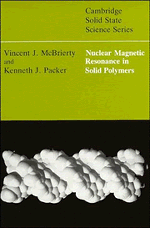Book contents
- Frontmatter
- Contents
- Preface
- Acknowledgements
- Glossary of terms
- 1 The NMR of solid polymers: an overview
- 2 Basic concepts in NMR
- 3 Nuclear spin interactions
- 4 Experimental methods
- 5 Structure and motion in solid polymers
- 6 Structural heterogeneity in polymers
- 7 Oriented polymers
- 8 Selected topics
- Appendix 1 Data on common polymers
- Appendix 2 The rotation operator
- Appendix 3 Rotation of tensors between coordinate frames
- Appendix 4 Spatial distribution of structural units in a polymer
- Appendix 5 The internal Hamiltonian
- Appendix 6 Spectral lineshapes
- Appendix 7 Analysis of spinning sidebands
- Bibliography
- References
- Author index
- Subject index
Preface
Published online by Cambridge University Press: 19 October 2009
- Frontmatter
- Contents
- Preface
- Acknowledgements
- Glossary of terms
- 1 The NMR of solid polymers: an overview
- 2 Basic concepts in NMR
- 3 Nuclear spin interactions
- 4 Experimental methods
- 5 Structure and motion in solid polymers
- 6 Structural heterogeneity in polymers
- 7 Oriented polymers
- 8 Selected topics
- Appendix 1 Data on common polymers
- Appendix 2 The rotation operator
- Appendix 3 Rotation of tensors between coordinate frames
- Appendix 4 Spatial distribution of structural units in a polymer
- Appendix 5 The internal Hamiltonian
- Appendix 6 Spectral lineshapes
- Appendix 7 Analysis of spinning sidebands
- Bibliography
- References
- Author index
- Subject index
Summary
Since its inception, nuclear magnetic resonance (NMR) has been used with remarkable success to investigate polymeric materials. However, application to solid polymers was for many years largely the province of physicists and physical chemists because of the need for specialised spectrometers to gain access to the broad spectra (usually H) typical of solids, and because interpretation of these spectra and associated relaxation times required theoretical models of a strongly physical nature. The chemist, meanwhile, was more than satisfied to exploit the enormous potential provided by the increasing power of liquid-state NMR spectroscopy which had benefited considerably from the introduction of Fourier transform (FT) methods, the availability of higher fields generated by superconducting magnets with concomitant enhanced sensitivity, formidable on-line computing capabilities, and the added flexibility of multidimensional NMR. The rich site-specific information in high-resolution liquid-state NMR remained undetected in early solid-state spectra because of the dominant dipolar contribution. Sustained efforts to achieve comparable results for solids led to procedures to suppress dipolar contributions using high-power decoupling techniques, sample spinning and the application of ingenious pulse sequences. Today the full power of high-resolution one-, two- and three-dimensional NMR is available for solid materials, albeit requiring more sophisticated experimentation and analysis. Specifically, multidimensional NMR permits different spin interactions to be correlated or separated, exchange between different states of a resonant nucleus to be monitored over selected timeframes and the intricacies of complex molecular motions to be elucidated.
- Type
- Chapter
- Information
- Nuclear Magnetic Resonance in Solid Polymers , pp. xv - xviiPublisher: Cambridge University PressPrint publication year: 1993



